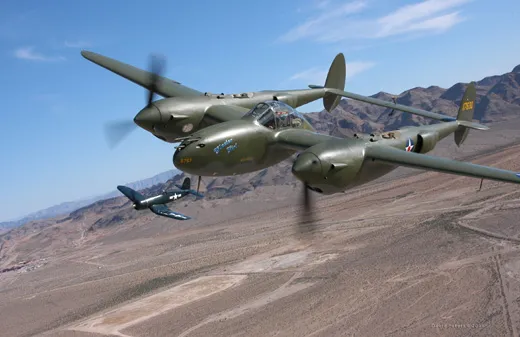Glacier Girl, Interrupted
Sixty-five years after its first attempt, the restored Lightning should finally reach England next year.
/https://tf-cmsv2-smithsonianmag-media.s3.amazonaws.com/filer/glaciergirl-631-jan07.jpg)
"Glacier Girl" is going to finish what it started.
The world’s most celebrated warbird, restored after being extracted from under 268 feet of ice in 1992, made an appearance at this year’s airshow at Nellis Air Force Base in Nevada, where its owners announced they’ve secured funding to fly the Lockheed P-38 Lightning from Maine to England next year. So, 65 years behind schedule, the airplane will finally get the chance to complete the flight it began during the desperate early days of World War II.
On July 15, 1942, P-38F no. 417630 was on a mission—part of Operation BOLERO, a high-stakes plan to send combat aircraft over a treacherous and largely uncharted route across the high north Atlantic—when weather and a lack of fuel forced it and seven other aircraft down on the eastern Greenland ice cap. The crews made it back to civilization and the war, but the airplanes were abandoned. For the next half-century, the Lightning, along with five other P-38s and two B-17s, all belonging to what became known as the Lost Squadron, slowly drifted deep into the ice.
In 1972 a series of expeditions got under way to locate and recover the warbirds. The 12th such attempt, funded by Kentucky entrepreneur Roy Shoffner and managed by Bob Cardin, was the first to achieve success. From May through August of 1992, the remains of 417630 were pulled from the glacier. Ten years and millions of dollars later, the P-38, restored to precisely the condition it had been in during the war (with the exception of nose art newly dubbing it "Glacier Girl"), took to the sky once again. It had long been Shoffner’s wish to fly the airplane to England—the original mission—but his death last year prevented the realization of that dream.
Now, thanks to an anonymous donor, the interrupted flight will be completed next summer. "Glacier Girl" is currently in Chino, California, where installation of modern avionics, including a GPS navigation system, gyros, and radios, is under way. The Lightning’s Allison V-1710 engines will be examined, and extra fuel tanks attached. Although the original propulsion package included turbo superchargers, Glacier Girl has only mechanical superchargers, so an alternative air source will be installed inside the cowlings to provide carburetor heat.
Once the airplane is ready, it will be flown home to the Lost Squadron’s home base in Middlesboro, Kentucky. Then it will retrace the original flight path from Presque Isle, Maine, through Goose Bay Labrador; Sonder Stroemfiord, Greenland; Reykjavik, Iceland; Prestwick, Scottland; and finally on to England, where it will arrive in time to participate in the 4th of July Duxford Airshow. The pilot for the flight will be Steve Hinton, who will scout the route ahead of time in a King Air that will also accompany the fighter on its journey.
Hinton is nonchalant about the trip. "I’ve flown it before," he says, and operationally, "it’s not a problem." But he does feel that the mission is special. It will complete "Glacier Girl"’s "purpose of life. It gives us greater understanding of World War II veterans and what they did in that war," he says. And with luck, the flight of "Glacier Girl" will coincide with a German expedition to the Greenland ice pack to recover the Lost Squadron’s remaining aircraft. "Needless to say, they’ll get a buzz job," Hinton says.
While Cardin feels that "Glacier Girl" ultimately needs to retire to a museum, his commitment to relive history does not end with the aircraft’s arrival at Duxford. "I’d like to see her fire her guns," he says. (Due to legal issues, the .50-caliber machine guns have not been operated.) After the England trip, Cardin would like to load "Glacier Girl" onto a U.S. Navy aircraft carrier for a symbolic retrieval from the European Theater of Operations. Once within range of the East Coast, Hinton hopes to launch from the carrier, arriving back in the United States as a symbol of American tenacity.
